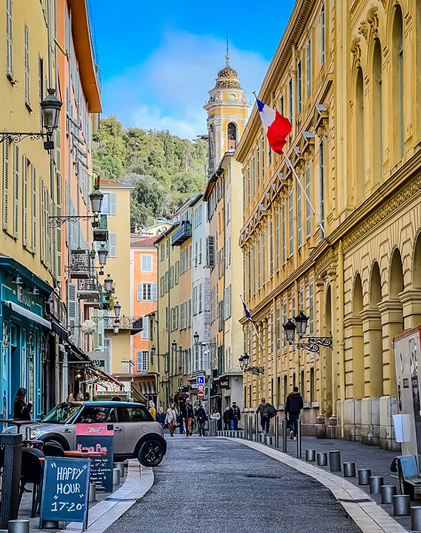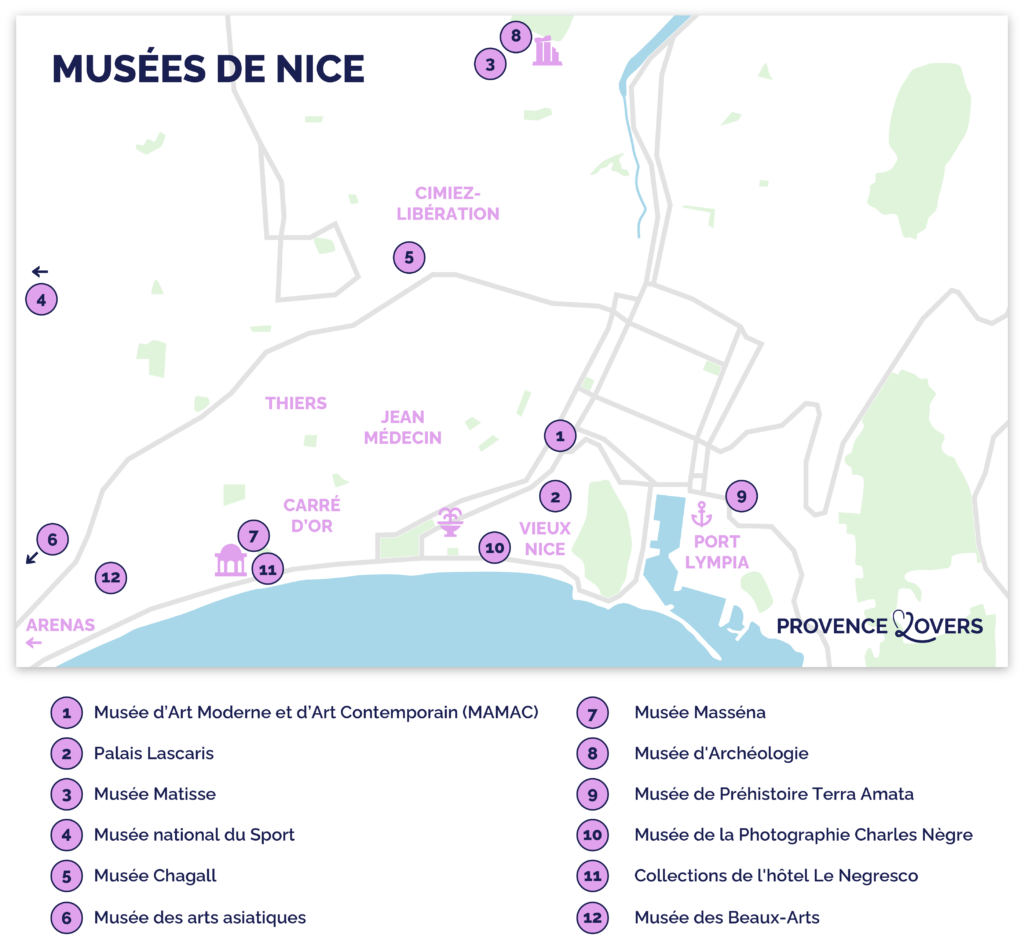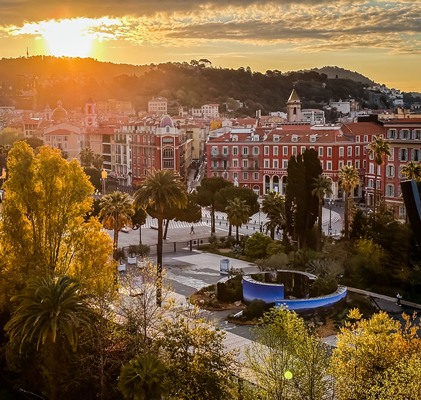If you’re an art lover visiting the Côte d’Azur, be sure to visit the Museum Matisse in Nice. Since 1963, the site has been dedicated to the work of the author of the great gouaches. Located in the villa des arènes on the Colline de Cimiez, it houses a magnificent collection of works by Henri Matisse and plays a key role in Nice’s vibrant cultural life. Paintings, engravings, drawings and sculptures… the artist’s creations are on display for your viewing pleasure!
Here are some useful tips for planning your visit to the Musée Matisse in Nice.

This guide is completely independent, based on our experiences. We visited the region anonymously, making our own choices and paying our bills in full.
Is a visit to the Museum Matisse worthwhile?
In our opinion, the Museum Matisse is a truly inspiring place to visit in Nice. The most memorable part of our visit, and well worth the detour:
- the artist’s emblematic creations, such as the statue Le Serf and the painting La Tempête in Nice,
- L’arbre de vie stained glass window with ultramarine blue, bottle green and lemon yellow glass, considered one of Nice’s artistic treasures,
- Blue Nude IV, one of our favorites, a large azure gouache cut-out and pasted on canvas, taken from a set of 4 gouache cut-out compositions, the Blue Nudes series.
It’s one of the city’s most beautiful museums and one of Nice’s best activities!

What you can see
The L’arbre de vie stained glass window, our favorite

The L’arbre de vie stained glass window is one of our real favorites among Henri Matisse’s works. Its ultramarine blue, bottle green and lemon yellow glasses won us over. Did you know that this marvel was one of the test pieces for the stained glass windows in the Chapelle des Dominicaines du Rosaire in Vence, a 40-minute drive from Nice? Considered one of the city’s artistic treasures, this stained glass window is a feat of engineering. As you get closer, you’ll notice that the ultramarine blue and bottle-green zones are transparent, allowing you to see the landscape through. Yellow is more opaque to accentuate the glare of the light.
Sketches and models

On the same floor, we walked through the artist’s many sketches. As here on the left, we admired the models for the pink calyx veil and the pink purse. Both on gouache paper, cut, pasted and mounted on canvas.

Henri Matisse was not only a complete artist, he also carried out a great deal of research before embarking on certain creations. Above, still in this space, we appreciated the model of the pavement for the Chapelle de Vence, a veritable culmination of Matisse’s plastic and artistic research. We learned that he had designed the Chapelle du Rosaire in Vence (just a 40-minute drive from Nice) alongside architect Auguste Perret and Soeur Jacques-Marie. This chapel was built for the Dominican Convent between 1948 and 1951.
OUR TPS FOR RENTING YOUR CAR IN Provence
- Compare prices on our preferred platform: DiscoverCars – one of the best rated sites.
- Choose a car that is powerful enough (the roads are steep) but compact (some passages are narrow).
- Think of thecomplete insurance (some roads are tortuous and narrow).
- There is a lot of demand, book it early.

Les Odalisques, or the harem by Henri Matisse

Let’s continue our stroll through the works of this genius of Fauvism and discover one of his key creations: the collection of Odalisques from the 1920s. The artist illustrated several nude models, dressed in Oriental-style harem costumes. This series is quite mythical, highly visual and inspired in particular by a modern Orient depicted in films shot in Nice at the time.

Through these various exotic characters, we’ve captured the codes and details that nourish the erotic imagination conveyed by Matisse. Contemplating the women depicted on these canvases, we were faced with veritable icons. This collection was a great success, inspiring many artists, in particular the American Tom Wesselman.
Sunset nudes: Tom Wesselman’s tribute to Matisse

We really enjoyed this room, which, in the same place, contrasted Henri Matisse’s Odalisques with a tribute by American artist Tom Wesselman. The latter was inspired by Matisse’s harem to create his colorful and sparkling Sunset nudes series. Above, Man ray at the dance intrigued us because it combines Matisse’s La Danse with the female nude. A form of mise en abyme of the works, a practice he regularly employs in his work.

The Odalisques are revisited to take on color and move at the tip of Tom Wesselman’s brush on these numerous canvases of oil paint.
The mythical Blue Nude IV

As the collection progressed, we rediscovered the diversity of Henri Matisse’s works, each more inspiring than the last. One of our favorites: Nu bleu IV, a large azure gouache cut and pasted on canvas. This is an “extract” from the Blue Nudes series of 4 gouache cut-outs.
From drawing to bronze sculpture

We really enjoyed this museum, which houses a vast collection of Henri Matisse’s creations. From sketches and paintings to sculptures and drawings, you’ll see that he was a truly all-round artist!
The red Moucharabieh, centerpiece of her textile collection

Did you know that Henri Matisse also created a textile collection? The perfect complement to his broad artistic palette! One of the highlights of his textile collection is the red Moucharabieh, which left us speechless. We found influences from North Africa, India and Turkey in the artist’s work. Matisse wove and hung these fabrics on walls or in front of windows to filter the Mediterranean light. We find his signature strong energy, arching rhythm and radiant motifs!
Objects and furniture: the artist’s personal collection

Henri Matisse was a virtuoso and a great collector of antique objects and furniture. Vase, fruit bowl, cheese cloche and its earthenware plate, glass bottle, marble and wrought-iron table… We were lucky enough to discover several pieces from his personal collection, bequeathed to the city of Nice by his heirs.
The “Claire Room” and its wall drawings

Do you know the story of the “Chambre Claire”? In December 1917, Henri Matisse arrived in Nice. He rented several rooms in various large hotels with sea views, where he painted his first canvases inspired by Nice. In 1938, he finally bought an apartment in the former Hotel Le Régina, now theHotel Excelsior Regina Palace, which had welcomed Queen Victoria at the end of the 19th century. The large-format archive images and Henri Matisse’s drawings on display in this room of the museum allowed us to enter the brightly-lit room where the artist exhibited his sketches.
An interactive, educational museum

The Henri Matisse Museum in Nice is one of our favorites because it’s so interactive and educational. We took advantage of the screens showing archive images and short reports. The works on display are also very varied, to appeal to all artistic tastes.

And don’t forget to take a look at the museum walls, many of which feature timeline friezes with numerous explanations and historical facts about Henri Matisse and the artists he inspired, such as Tom Wesselman.
We also liked the Atelier du Matisse Lab within the museum, which offers families the chance to take part in educational and practical art workshops for young and old alike.
Outside the museum: Parc de la Colline de Cimiez

The Musée Matisse is housed in the 17th-century Villa des Arènes on Nice’s Colline de Cimiez. From the moment we arrived, we were charmed by this beautiful building surrounded by cypress, olive and palm trees, amidst Roman ruins.
The Colline de Cimiez is a place we really enjoyed, first and foremost for its archaeological past and the remains of the ancient Roman city of Cemenelum. The Musée d’Archéologie is just a few minutes’ walk from the Musée Matisse. The park is also a great place to take a stroll or have a picnic before or after visiting the museums!
WHERE TO STAY IN Nice
Our favorites: neighborhoods and hotels
On the waterfront, with sea view:
Anantara Hotel – See prices, photos and availability
In the new town, close to the sea:
Hotel Apollinaire, elegant and bright – See prices, photos and availability
In the old town, with all the charm:
AparthotelAMMI Vieux Nice very practical and pleasant – see prices, photos and availability

Musée Matisse in Nice: how to get there
Where to find the museum
- In Nice
- Near the Musée d’Archéologie on the Colline de Cimiez
- From Nice-City station = 35min on foot and 10min by car
Here’s a map of Nice’s best museums to help you find your way around:

Access by car and parking
- You can park in the Musée Matisse parking lot in front of the Monastère de Cimiez.
- During our visit, we parked on Avenue Bellanda, opposite the entrance to the Musée d’Archéologie on the Colline de Cimiez, just like the Musée Matisse.
- There are also a few parking spaces on Avenue du Monastère, above the Jardin des Arènes de Cimiez.
Public transport access
By public transport, Lines 5, 18, 16, 40, 33 and 70 buses will take you there (stop “Arènes / Musée Matisse”).

Access on organized tours
The Henri Matisse Museum is one of the must-see places in Nice. You can choose to go there on your own or include it in an organized tour:
- with audioguide in several languages – see options
- with private multilingual guide – see options
Visiting difficulties
We did not identify any particular difficulties, as the museum is equipped with ramps and elevators to access the various areas.
Please note that you must leave large personal items (such as bags, snacks and drinks) in locked lockers at the entrance. Bring a €1 coin and a small bag.
For people with reduced mobility and strollers, enter the Arènes garden via the gate at 164 avenue des Arènes or the one on boulevard de Cimiez, then enter the museum via the southern forecourt of the villa.
WC facilities are located on the museum’s 1st level. Alternatively, you’ll find public toilets in the Jardin des Arènes de Cimiez.
HAVE FUN WITH THESE activities
- Great kayak trips in:
Saint-Tropez to the Ramatuelle reserve
Cassis to the calanques - Helicopter flight from Cannes
- Shuttle service along the coast between Nice and Saint-Tropez
- Bike tours: eBike in Nice – Mountain biking in the Esterel massif

Visit the Henri Matisse Museum: useful tips
Schedules and prices
The museum is open every day except Tuesday:
- 10 a.m. to 5 p.m. November to April
- 10 a.m. to 6 p.m. May to October
- closed on January 1st, Easter Sunday, May 1st and December 25th
The ticket office closes 30min before the museum closes. The normal rate is €12 per person, but we recommend you opt for the 3-day Museums Pass, which gives you access to all Nice’s municipal museums for 72 hours.
See the latest news on the official website here.
How long
We recommend you allow between 1h30 and 2h, depending on your interest in the artist and his creations.

Best moment
It’s one of Nice’s finest museums and a popular cultural venue in the city. We recommend you go when it opens in the morning, and on weekdays to avoid the crowds. The museum is open all year round, although it is particularly busy in summer. Note that visiting Nice and its museums outside the summer season, in autumn, spring or winter, can also be a good option!
Direction of visit
There’s no set way to visit this museum. We recommend that you start on the 1st floor and work your way up, following the room numbers. You can then finish with a tour of the Parc de la Colline de Cimiez on your way out.
Visiting with children
This museum is just the thing for kids, to awaken the artist in them! First of all, we liked the variety of the works, the colors, textures and shapes. With sculptures, drawings, sketches, canvases and textiles, your children will be as delighted as you are.
The museum’s Atelier Matisse Lab offers activities and workshops for children and adults. There’s plenty to keep the whole family busy at the Musée Matisse in Nice, so you and your children can share an art-focused moment together.

Please note that strollers are allowed inside the museum (PMR access, see above), and small folding stools are available at reception for your children to take a break along the tour route. More information on the official website here.
Eating out
There are no refreshment areas inside the museum, and it is forbidden to bring snacks into the exhibition halls. You can leave your belongings in lockers at the entrance. However, you can picnic in the Parc de la Colline de Cimiez, where the museum is located. You can also take a look at our suggestions for the best places to eat in Nice.
Hotels
You’re right in the heart of Nice. See our article on the best hotels.
For a stay in a luxury setting, you can also consult our articles on:
- the best 5-star hotels in Nice
- the best hotels on the Promenade des Anglais in Nice
DISCOVER Nice
- Best things to do in Nice
- Where to stay in Nice: 15 best hotels
- Where to eat in Nice: 20 best restaurants
- The 12 best museums in Nice
- Best beaches
- Visit the Palais Lascaris
- Visit the MAMAC Museum
- Visit the Museum of Photography
- Itineraries: 1 day – 2 days – 3 days – 5 days – 7 days
- Rent a car in Nice (airport or train station)
- Most beautiful villages around Nice



